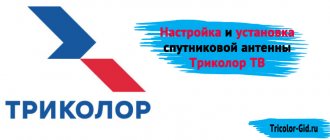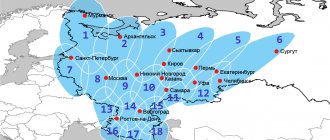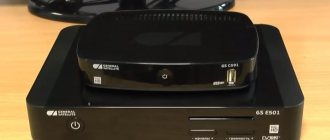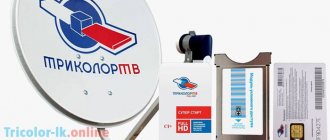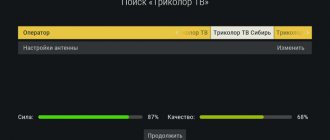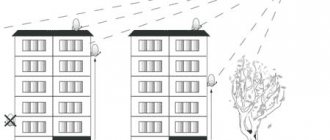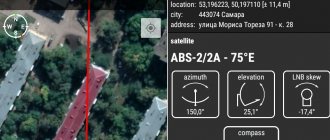Where is the best place to install the Tricolor satellite dish?
It is impossible to set up the Tricolor dish without choosing the right place to install it. The plate must be installed only on the wall of the house located on the south side. If the apartment is located so that all the windows face other sides, you need to fix it where the South is closest, and then tune it to the satellite.
When choosing a wall, you need to focus on one more important factor: there should be no tall buildings or trees in the immediate vicinity of the dish; they can interfere with the signal.
The closer the dish is located to the TV, the better the signal will be and the easier the setup work will be.
Unfavorable places to install the Tricolor plate:
- glazed balconies and loggias;
- places without drainage systems;
- an area where the plate can be covered with snow;
- roofs with a gable roof or more, asymmetrical roofing.
Choosing an installation location
First of all, you need to choose a suitable location for the satellite dish. There should be no obstacles between the antenna and the intended location of the satellite: trees, walls, buildings, glass, etc. The installation site must be not only free, but also accessible.
It is recommended to install the Tricolor satellite dish on the roof of the house or chimney, near a window or outside the balcony. It is not recommended to mount the plate inside a glazed loggia, near gutters or in places where snow, ice and liquid accumulate.
Primary requirements:
- The Tricolor antenna should be installed at a height of at least 3 meters.
- The plate should be facing south. This improves signal and image quality.
- There should be no obstacles (walls, glass, trees, etc.) within a distance of 100 m.
- The antenna should be close to the TV. If the dish is located 100 m from the device, it is necessary to install an amplifier.
Compliance with all recommendations will ensure a good signal and high image quality. The equipment also affects the operation of the TV. For example, the price of a Tricolor antenna with two receivers is 9,990 rubles, and the basic set will cost 4,990 rubles.
How to assemble the Tricolor TV dish and install the main elements?
Contrary to the popular belief that assembling and installing a satellite dish yourself is difficult, and in general, almost impossible, this is not so. If you know the exact algorithm of operation and follow the instructions described below, you can cope with the task yourself without spending a lot of time.
So, are you ready to surprise your family and friends with your skills? Then let's go!
- The first step is to install the massive bracket that is included in the Tricolor TV kit. The types of fasteners and tools depend on the type of wall - it is load-bearing or permanent.
- When fixing the bracket, you need to take into account that the converter located on it must be installed downwards in order to protect the plate from falling asleep with precipitation.
- Next, you need to securely secure the converter and cable together using the F-connector. To do this, you will need to free the cable from the top insulation by no more than 10 mm. Next, you need to wrap the cable tightly with braided shielding and foil. The inner insulating layer also needs to be removed by 10 mm and the connector must be tightened as much as possible.
- You need to prepare stitches and electrical tape in advance to install the cable in the arc of the converter holder.
- Sealing is a necessary procedure and cannot be avoided. It should extend along the entire length of the cable. In some cases, silicone sealant may be needed.
- Then you need to fix the antenna to the bracket. It must be installed so that at any time it is possible to rotate the plate in different directions.
- The last stage of assembly: you will again need insulating tape and zip ties, since on the bracket, in addition to the antenna, the cable itself must be fixed. If you secure the cable with a small margin, this will subsequently facilitate installation and repair of the device, if necessary.
The most difficult stage on the path to satellite television has been overcome! We suggest moving on to installing the television connector.
Tools and materials for work
To work you will need:
- Drill (perforator);
- Screwdriver;
- Wrenches of the 8, 10, 13 type;
- Open-end wrench 10;
- Pliers;
- Compass;
- Knife;
- Insulating tape;
- Heat-shrinkable tubing or silicone-based sealant;
- Screeds;
- 13mm head screws, 6 - 8 cm long;
- Metal washers d=30-50 mm.
Minimum set of tools.
To secure the base, you need to select fasteners. It should be fixed to a wooden surface using plumbing caps. In other situations, 10x100 anchor bolts are suitable.
The cable used to connect the antenna and the TV must contain a thick copper core and double braid. The cable length is no more than 100 m. If it is necessary to lay more than this length, then signal amplifiers are additionally located.
Installation of a television connector
Preparing a television connector for installing satellite television is easy if you follow the following instructions:
- in order not to damage the shielding braid, you need to remove the cable from the top insulation by about 15 mm;
- shielding braid and foil must be located along the entire length of the cable;
- Next, you need to remove 10 mm of the inner insulation layer from the cable;
- the next stage is to screw in the connector as much as possible and use wire cutters to disconnect the conductor, which should extend beyond the edges no more than 3 mm.
The video broadcast to the TV using the installed Tricolor dish directly depends on the quality of the work carried out by the installer. You should follow the order of the instructions very carefully. You need to put all your strength and work into setting up Tricolor TV!
Setting up an antenna for a satellite
Having detailed background information, it will not be difficult to set up a satellite dish yourself. Today there is an application for mobile phones and tablets called SatFinder. In it you can select a satellite television provider or find a specific broadcaster by its name. The application produces the following data.
- Direction to the satellite on the map, allowing you to choose the correct side of the house for installing the antenna.
- Horizontal azimuth. This parameter describes how many degrees the plate should be rotated relative to the north-south direction. Today, every phone has a software compass that makes it easy to check the correct installation.
- The deflector is tilted vertically. You need to be extremely careful with this parameter. Some antenna manufacturers make a converter-deflector system. Other products require adjustment of the angle of inclination.
Having all the configuration data in hand, the user must mount, secure, rotate and tilt the antenna. Then you can do fine positioning. To do this, select an info channel on the TV (how to call it depends on the tuner and TV model). Then, by gradually turning and changing the tilt of the antenna, you should achieve maximum indicators in the lower corner of the screen.
How to adjust the Tricolor TV dish?
The better and more accurately the plate is adjusted, the better the image on the TV will be. The adjustment feature depends on the angle and azimuth of the place where the antenna is installed. These quantities are measured in degrees.
The difficulty in choosing azimuth and angle is that it varies in some regions. To find out what values are needed for a particular region, you need to go to the Tricolor website.
If for some reason the channels are lost, or the display is poor, it is necessary to adjust the azimuth and angle again.
After setting the required values on the plate, you need to connect the cable from the antenna to the television connector. When you turn on the TV, you don’t need to immediately tune in to the channels, you just need to check for a signal from the satellite.
Preparing to purchase an MTS antenna
Before purchasing an installation package, which contains not only the tariff itself (the number of channels for a certain fee), but also the necessary equipment, the user needs to check the signal. You can go to the official website to look for the presence of a signal in the “Interactive Map” section. As a rule, the signal is available almost everywhere with the exception of the Chukotka Autonomous Okrug and Kamchatka Territory.
It is recommended to purchase an installation package with a satellite dish, as this will ensure high-quality broadcast of TV shows. The user will receive a discount, just order the package on the official website by going to the “Satellite TV” section. You should pay attention to the presence of an HD set-top box or cam module. To connect via the module you need to have a CI slot on your TV.
After the user has purchased a satellite television set, he will need to find a place where he can install the antenna. It is desirable that there are no obstacles - the signal should not “bump into” objects. Therefore, it is best if there are no buildings or trees nearby. The surface for installing the antenna must be flat.
How to set up a Tricolor TV signal?
- To set up free Tricolor TV channels and their signal, you will need to go to the “Antenna Settings” menu. Then you need to move the antenna cursor in the plane to such an extent until a signal is received that satisfies.
- There should be no interference in the form of dots and ripples on the screen, and the sound should be of high quality, almost perfect!
- The next step is to open the “Received signal level” tab.
- Next, use the receiver’s remote control to press the “MENU” button.
- It is convenient to use the arrow buttons; you need to find the “Settings” tab, then confirm the command by pressing the “OK” button.
- For further installation, a password must be entered. At the initial stage, the provider provides for the introduction of four zeros. You can change it yourself later.
- Next you need to go to the “System Settings” tab and confirm the command again by clicking “OK”.
- Next, you need to enter the “Antenna Settings” menu and confirm the request.
After the Tricolor subscriber selects the antenna installation mode and the list of channels, you need to determine the satellite that corresponds to the region: Eutelsat 36A or Eutelsat 36B. You need to find two scales in the antenna installation menu tab; they characterize the signal level and its transmission to the satellite. If both of them are filled to the 70% mark, it means that all the work was carried out correctly and the channels on Tricolor TV will be shown in high quality.
Satellite antenna device
The main types of failures concern converters. The plate can only be damaged on purpose. Indeed, why should a piece of iron break? The construction of a satellite dish is ridiculously simple:
- a plate is hung on a bracket from the wall;
- Irradiators are placed in the focal plane of the paraboloid.
All! A signal arrives from a satellite, the object is far away, the lines are considered to be parallel. As a result, according to the laws of optics, the signal is collected in the focal plane. For offset antennas, the dish is not perpendicular to the direction of the satellite, the feed is far from the center. On the contrary, in direct-focus antennas the converter is located along the axis, due to which part of the signal is lost. This is an inevitable drawback. With offset antennas, the feed hangs outside the dish; another factor appears: the ray collection area is proportional to the cosine of the deviation from the perpendicular. It cannot be said that the first design is better or worse than the second.
Offset antennas are useful where there is no chance of tilting the dish so that the axis points directly at the satellite. These are predominantly equatorial and tropical regions. In practice, offset antennas are found no less often than direct focus ones. It is incorrect to call an irradiator a converter and vice versa. The device hanging near the focal plane of the antenna includes:
- Irradiator. It looks like a conical opening, protected from precipitation by a removable plastic cover.
- Depolarizer. A section of a straight waveguide (pipe) where a dielectric plate and a pair of rods stand. Serves to convert circular polarization to linear.
- Converter. Represents the electronic unit where the satellite frequency is reduced to 1 or 2 GHz for transmission along the feeder with the least loss. A low-noise amplifier is additionally located here. The sensitivity formula is dominated by the characteristics of the first active stage. It is important to reduce the noise level here.
The matter is complicated by satellite broadcasting on a frequency range. C and Ku bands accepted. Each one is dominated by its own type of polarization. On C it is circular, on Ku it is linear. Newcomers are perplexed. We explain that the C band used in the Russian Federation has circular polarization for a number of reasons:
- The legacy of a difficult past. In the USSR, circular polarization was used on spacecraft for satellite transmission of information; the spy orbit differed from geostationary. It was not necessary to take into account the polarization inclination angle, as when using the horizontal type.
- The polarization vector is deflected by magnetic fields. Solar storms and fluctuations in terrestrial characteristics affect the tilt angle. Moreover, the Faraday effect decreases with increasing frequency. Therefore, in the Ku band it is not too scary.
Such features simplify setting up the equipment; there is no need to rotate the converter around its axis, which is great - the angle is difficult to catch. If C and Ku are broadcast with linear polarization, the Faraday effect affects differently, as a result it is impossible to adjust the antenna as desired. This is worse than the losses created by a hybrid converter. It’s difficult to estimate, but the closer the subscriber is to the pole, the stronger the distortion. The Russian Federation lies in the northern territories.
We add that the Ku and C ranges are so large that the sections are further divided, otherwise it is impossible to construct local oscillators to obtain intermediate frequencies (see above). Satellites do not capture the entire spectrum, which is taken into account by converters. Keep the advice:
In addition to the range, check the provider's subrange. When choosing equipment, make sure that the converter supports the wave.
The converters look similar: a steel box, a section of pipe, opened, the structure is sewn into plastic, covered with a cover from the entrance side. In terms of geometric dimensions, there is a difference for the ranges, but the filling is more important. In any case, electronics have their own bandwidth; without a match, the signal will not pass through. Let's say more - manufacturers keep the hardware inside the equipment secret, so some converters operate outside the standard limits; this is more an exception to the rule than a constant pleasant surprise for the user. Hybrid converters work at all frequencies (check), there are two receivers inside.
Diseqc switch.
We connect the cables from the heads to the diseqc switch. We write down which switch port (the ports are numbered) each satellite corresponds to. For example, we will connect a converter that receives a signal from the Amos satellite to the first port, Sirius to the third, Hot Bird to the fourth.
amos 1/4sirius 3/4hot bird 4/4
Next, connect one end of the cable to DiSEqC to the “Reseiver” (out, RW) port, and the other to the tuner’s “LNB IN” socket. Connect the receiver to the TV and turn on the receiver.


